
NGC 6791 is an open star cluster in the Lyra constellation. It was discovered by Friedrich August Theodor Winnecke in 1853. At roughly 8 billion years old, and with an iron to hydrogen abundance ratio that is more than twice that of the Sun, it is one of the oldest and most metal-rich clusters in the Milky Way. This is contrary to the typical rule-of-thumb where older means more metal-poor. Compounded with the fact that it has an unusually high population of stars, NGC 6791 is among the most studied clusters in the sky.

NGC 5822 is an open cluster of stars in the southern constellation of Lupus. It was discovered by English Astronomer John Herschel on July 3, 1836, and lies close to another cluster, NGC 5823, which suggests there may be a physical association.
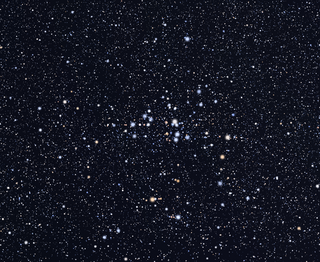
NGC 6087 is an open cluster of 40 or more stars centered on the Cepheid variable S Normae in the constellation Norma. At a distance of about 3500 ly and covering a field of almost one quarter of a degree, the stars range from seventh- to eleventh-magnitude, the brightest being 6.5 magnitude S Normae. The aggregate visual magnitude of the cluster is about 5.4.
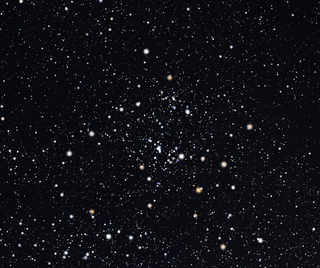
NGC 6755 is an open cluster of stars in the equatorial constellation of Aquila, positioned about 3° to the east of the star Delta Aquilae. It was discovered by the Anglo-German astronomer William Herschel on July 30, 1785 and is located at a distance of 8,060 light years from the Sun. NGC 6756 lies 30′ to the northeast of NGC 6755, with the pair forming a visual double cluster. However, they probably do not form a binary cluster system since they have different ages and are too distant from each other.

NGC 6820 is a small reflection nebula near the open cluster NGC 6823 in Vulpecula. The reflection nebula and cluster are embedded in a large faint emission nebula called Sh 2-86. The whole area of nebulosity is often referred to as NGC 6820.

NGC 637 is an open cluster of stars in the northern constellation of Cassiopeia, positioned about 1.5° to the WNW of the star Epsilon Cassiopeiae. The cluster was discovered on 9 November 1787 by German-born English astronomer William Herschel. It is located in the Perseus Arm of the Milky Way, at a distance of approximately 7.045 kilolight-years from the Sun. The cluster is small but compact, and is readily visible in a small telescope.
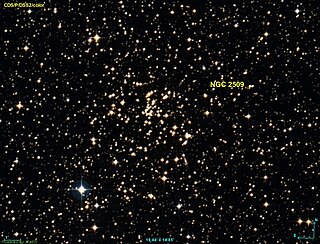
NGC 2509 is an open cluster in the constellation of Puppis. It was discovered on 3 December 1783 by William Herschel. It was described as "bright, pretty rich, slightly compressed" by John Louis Emil Dreyer, the compiler of the New General Catalogue.

NGC 110 is an open star cluster located in the constellation Cassiopeia. It was discovered by the English astronomer John Herschel on October 29, 1831.

NGC 6380 is a globular cluster located in the constellation Scorpius. It was originally discovered by James Dunlop in 1826, and he named it Dun 538. Eight years later, in 1834, it was independently rediscovered by John Herschel and he named it H 3688. The cluster was re-rediscovered in 1959 by Paris Pişmiş, who catalogued it as Tonantzintla 1 — and referred to it as Pişmiş 25. Until the 1950s NGC 6380 was thought to be an open cluster. It was A. D. Thackeray who realised that it was in fact a globular cluster. Nowadays, this cluster is reliably recognised in widely available catalogues as a globular cluster, and referred to simply as NGC 6380.

NGC 299 is an open cluster of stars in the main body of the Small Magellanic Cloud – a nearby dwarf galaxy. It is located in the southern constellation of Tucana, just under 200,000 light years distant from the Sun. The cluster was discovered on August 12, 1834, by English astronomer John Herschel.

NGC 361 is an open cluster in the Small Magellanic Cloud. It is located in the constellation Tucana. It was discovered on September 6, 1826, by James Dunlop. It was described by Dreyer as "very very faint, pretty large, very little extended, very gradually brighter middle." At an aperture of 31.0 arcseconds, its apparent V-band magnitude is 12.24, but at this wavelength, it has 0.40 magnitudes of interstellar extinction.

NGC 458 is an open cluster located in the constellation Tucana. It was discovered on September 6, 1826, by James Dunlop. It was also observed by John Herschel and DeLisle Stewart. It was described by Dreyer as "pretty faint, large, round, very gradually brighter middle". It was also noted in the second Index Catalogue that it was "probably a cluster, extremely small, close, no nebulosity seen by D.S. ." At an aperture of 31 arcseconds, its apparent V-band magnitude is 11.73, but at this wavelength, it has 0.12 magnitudes of interstellar extinction.
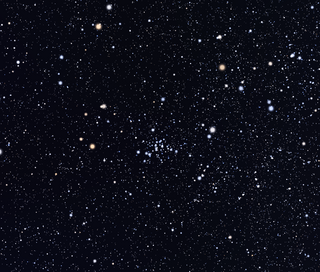
NGC 4103 is an open cluster in the constellation Crux. It was discovered by James Dunlop in 1826. It is located approximately 5,000 light years away from Earth, in the Carina-Sagittarius arm.

NGC 1624, also known as Sh2-212 in the Sharpless catalog, is a very young open cluster in the constellation Perseus inside an emission nebula. It was discovered by German-British astronomer William Herschel in 1790. NGC 1624 is about 20,000 ly from Earth, and latest estimates give it an age of less than 4 million years. Its apparent magnitude is 11.8, and apparent diameter is about 3.0 arc minutes. Its celestial location is right ascension (α) 04h 40m 36.0s and declination (δ) +50° 27′ 42″. It is potentially an area of massive star formation.

NGC 1980 is a young open cluster associated with an emission nebula in the constellation Orion. It was discovered by William Herschel on 31 January 1786. Its apparent size is 14 × 14 arc minutes and it is located around the star Iota Orionis on the southern tip of the Orion constellation.

NGC 515, also occasionally referred to as PGC 5201 or UGC 956, is a lenticular galaxy located approximately 228 million light-years from the Solar System in the constellation Pisces. It was discovered on 13 September 1784 by astronomer William Herschel.
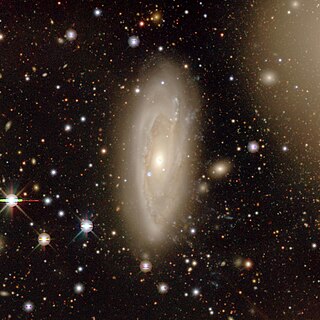
NGC 3312 is a large and highly inclined spiral galaxy located about 194 million light-years away in the constellation Hydra. The galaxy was discovered by astronomer John Herschel on March 26, 1835. It was later rediscovered by astronomer Guillaume Bigourdan on February 26, 1887. NGC 3312 was later listed and equated with IC 629 because the two objects share essentially the same celestial coordinates. NGC 3312 is the largest spiral galaxy in the Hydra Cluster and is also classified as a LINER galaxy.

NGC 1444 is a small open cluster of stars in the northern constellation of Perseus, about 2-1⁄4° to the northwest of 43 Persei. It has an angular diameter of 4 arcminutes and a brightness of 6.60 in visual magnitude. The cluster has sixty members of seventh magnitude or fainter, and is better appreciated in larger telescopes. NGC 1444 was discovered on 18 December 1788 by the German-British astronomer William Herschel. It is located at a distance of 4,200 light-years from the Sun and is about 7.1 million years old. The cluster has a physical core radius of 1.73 ± 0.42 ly and a tidal radius of 17.4 ± 4.2 ly. The most prominent member is the triple star system Σ446, with a magnitude 6.7 primary. The cluster is a member of the Camelopardalis OB1 association.


















